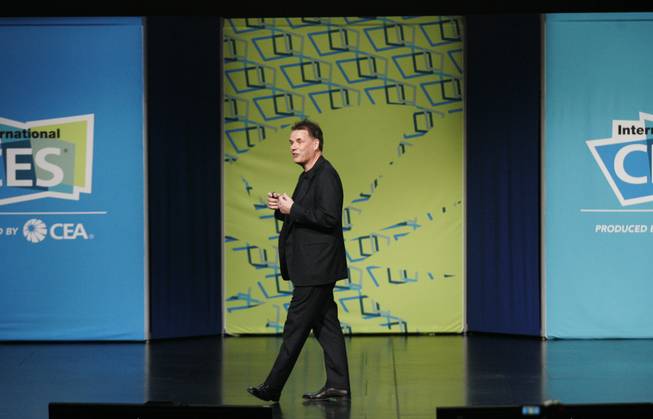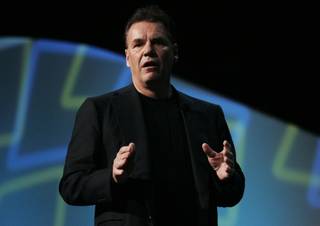
Sam Morris / Las Vegas Sun
Nokia President and CEO Olli-Pekka Kallasvuo delivers a keynote address during the annual CES Friday, January 8, 2009.
Friday, Jan. 8, 2010 | 11:28 a.m.
Related stories
- At CES, Intel chief says fully connected homes on the horizon (1-10-2010)
- Industry working to clear up misconceptions about 3-D television (1-8-2010)
- Consumers want on-demand video, but media companies not delivering (1-8-2010)
- Ford unveils in-vehicle 'Touch' technology at CES (1-7-2010)
- Gadgets and garters: It’s convention in Las Vegas (1-7-2010)
- Puff of air controls new computer mouse (1-7-2010)
- Sony aims to become global leader in 3-D (1-7-2010)
- Microsoft anticipates 'biggest year ever' for the Xbox (1-6-2010)
- Las Vegas braces for 110,000 at Consumer Electronics Show (1-6-2010)
- Consumer Electronics hot ticket: 3-D television (1-6-2010)
- Analysts predict flat electronics sales for 2010 (1-6-2010)
- What others are saying about CES (1-6-2010)
For Americans, a mobile phone is almost a necessity. But to those in emerging countries, a mobile phone can be an investment in health, wealth and overall well-being.
A farmer in India can use a mobile device to receive crop prices and advance his business. Another family can use it to learn English.
Nokia President and Chief Executive Olli-Pekka Kallasvuo discussed Friday how his company is helping to play a role in such technology advancements during the Technology in Emerging Countries keynote address at the Consumer Electronics Show.
Nokia developed its first entry-level phone, the Mobira Cityman, in 1987, originally priced at $6,000. Today, someone in India or Indonesia can buy Nokia’s basic 1616 for $32, a price that still can be more than a month’s income in developing countries, Kallasvuo said.
Even then, the mobile phone isn’t a personal device, he explained. Neighbors or entire villages often will pool their money to jointly afford the investment.
“The idea that people with so little decide to invest their heart and hard-earned money in a mobile phone … that humbles me,” Kallasvuo said.
Kallasvuo said Nokia sold 750 million entry-level phones in 2009, like the Nokia 1616, adding to the total of 4.6 billion mobile subscribers worldwide.
What Americans consider a basic phone isn’t so basic to those in emerging countries. It’s a way to advertise a local business through more than word of mouth, Kallasvuo said. Nokia offers a free e-mail service called Ovi on many of its mobile phones and more than 5 million have signed up for the service, Kallasvuo said.
“Simple tech can make a difference in people’s lives. It’s not always about keeping in touch … We all know cell phones can be used to buy goods and services,” Kallasvuo said “Without banks or ATMs, think about how valuable cell phones are to pay bills.”
Researchers like Jan Chipchase are conducting studies in emerging countries to better understand the services Nokia can provide at affordable prices.
Chipchase, who has traveled from the hills of Afghanistan to the freezing temperatures of Mongolia with Nokia researchers, said the team learns how locals will use the technology by being present in their everyday lives.
“How can people who can’t read and write navigate a world of words and numbers?” Chipchase said. “How do you keep your device charged when you don’t have electricity?”
In his travels, Chipchase said Nokia has learned that it’s actually behind in the apps race. Businesses in countries like India have developed applications to fit the needs of their local people.
The apps don’t use a 3G network like they do in the United States, Kallasvuo said -- they use SMS, a system that is more accessible and affordable for developing countries.
But Nokia is catching up to those local businesses, Kallasvuo said. A developer in Palo Alto, Calif., for example, can create an application and send it across the world through Ovi in the matter of an hour.
Kallasvuo also detailed during his keynote a partnership with travel guide service Lonely Planet to continue to extend Nokia’s research around the world. The two companies have formed Project Progress, where Lonely Planet’s journalists interview locals during their travels on how they are using their mobile phones.
Kallasvuo ended his keynote with the announcement of the Nokia Economic Growth Venture Challenge, which is intended to challenge innovators to better develop technology for emerging countries. The requirements: The technology must perpetuate a local, vibrant business and improve the standard of living in an area where people earn less than $5 a day.
Kallasvuo announced the prize would be a $1 million investment in the winning innovation.
We want to put our money where our mouth is,” Kallasvuo said. “We approach things with the mindset that you can do good business and good at the same time.”


Join the Discussion:
Check this out for a full explanation of our conversion to the LiveFyre commenting system and instructions on how to sign up for an account.
Full comments policy